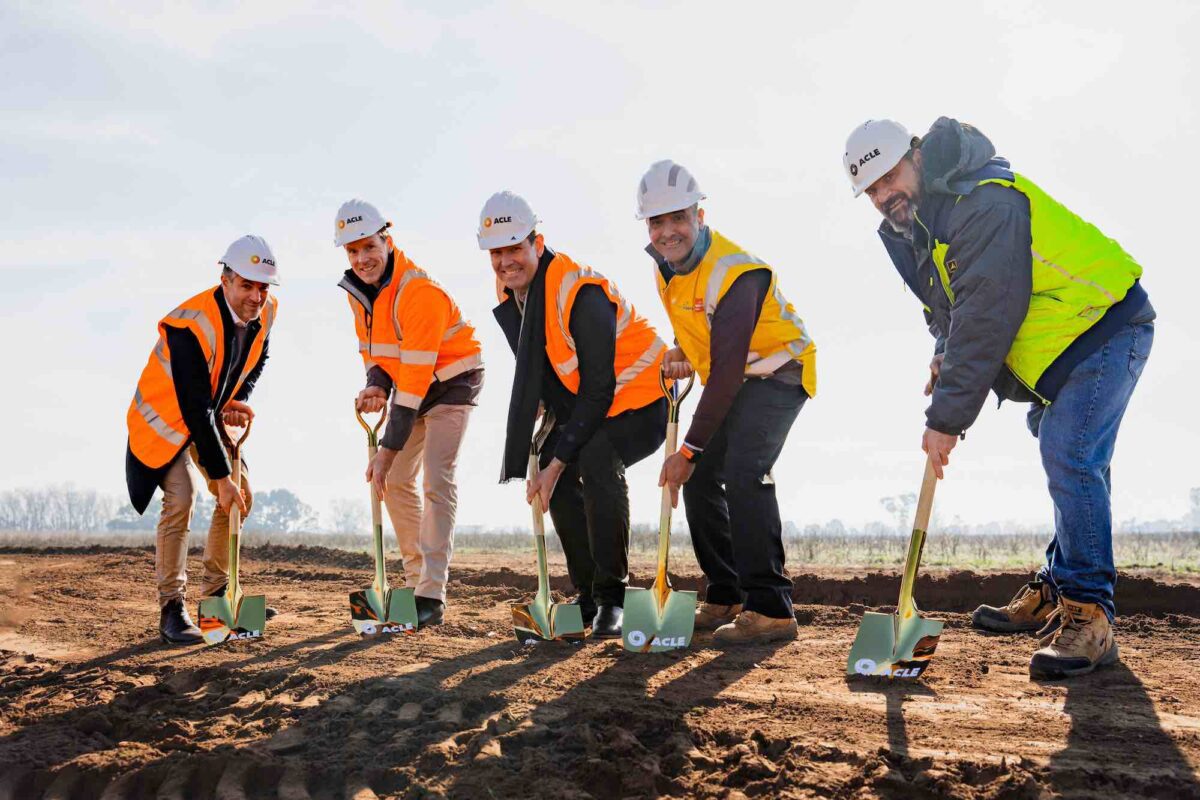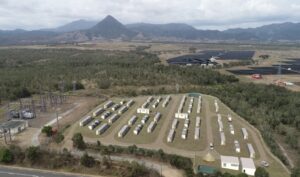Developers have broken ground on plans to build, own, and operate dozens of 5MW, two-hour batteries on distribution networks in regional Australia, in a bid to fill a “crucial gap” between home energy storage and grid-scale big batteries.
The portfolio of 27 distribution battery energy storage systems, or DBESSs, was announced earlier this month by Sustainable Energy Infrastructure (SEI) and clean energy developer Acenergy (ACE), targeting a total of 135MW/270MWh of batteries installed across three states.
The first phase of the project – the construction of seven 5MW, two-hour batteries on the regional Victorian network operated by Powercor – had its official launch on Wednesday, with a sod-turning at a site in Tongala, Victoria.
The installation of mid-scale batteries in front of the meter – in amongst the poles and wires and substations that transport electrons to and from households – offers a solution to a number of problems facing distribution networks trying to manage increasingly high penetration of rooftop solar.
The idea is that they soak up the excess solar that floods the grid during the middle of the day, and then discharge it back into the grid at night, theoretically making the evening peak power cheaper for all, and not just those households able to install rootop PV.
The difficulty is in working out who builds and owns these assets, how they are managed and monetised, how to ensure net benefits make it through to customers in the form of cheaper power bills, and where monopoly network companies stand in all of this.
Currently, distribution network companies like Powercor are restricted from developing their own community-scale batteries on their own networks, due to ring-fencing rules – although recently there have been exceptions made to these rules while some trials take place under the watch of (and with funding from) Arena.
DNSPs argue, however, that they are in a superior position to roll out community-scale batteries, with the knowledge of where best to locate them and easy access to existing assets, infrastructure and know-how. They also note that installing batteries of this scale can them help avoid other more costly infrastructure upgrades, thus pushing down the network component of household bills – a win for all.
Finally, the network companies argue they can do this quickly – much more quickly than big battery developers – chipping away at Australia’s urgent need for energy storage, particularly with rooftop solar now tipped by the Australian Energy Market Operator to quadruple to around 86 GW by 2050.
Certainly, in states like Queensland and Western Australia where the network companies are state-owned, they are getting on with the job.
Outside of the network industry, however, consumer advocates argue that community batteries should be exactly that – owned by the community and at the service of the both those households unable to store their excess rooftop solar and those households unable to install solar, at all.
In this case, it is two clean energy developers and investors taking the initiative to install DBESSes, one of which – ACEnergy – has made the development and delivery of mid-scale renewable energy assets its specialty.
“Developing projects in distribution networks has been a cornerstone of our operations,” said ACEnergy managing director Raymond Wang in a statement this week.
“With extensive knowledge and experience throughout regional Australia, we are confident in successfully delivering these projects, as we have consistently done before.”
Saji Anantakrishnan, SEI director and PATRIZIA Infrastructure’s head of Australia and Asia, says the batteries are about supporting Australia’s energy transition while also providing stability to local communities.
“The partnership between SEI and ACE is typical of our mid-market infrastructure strategy, which focuses on building long-term complementary partnerships with experienced industry counterparties to ensure strong value creation through an identified pipeline of growth opportunities.”
Leading construction is ACLE Services, which announced on Wednesday that it has been tasked with Engineering, Procurement and Construction (EPC) of the DBESS portfolio – including the 20 phase two batteries totaling 100MW/200MWh that will be installed in Victoria, South Australia, and New South Wales.
ACLE says commissioning of the battery systems is planned to be carried out progressively to July 2025, with the company also being called on to operate and manage the batteries under a long-term O&M contract.
“ACLE is committed to providing the critical energy infrastructure the nation needs, on time and on budget, and our track record shows this,” the company’s director, Brenton Moratto said on Wednesday.
“We are keen to continue to contribute to Australia’s renewable transition, ensuring its sustainability through robust storage infrastructure.”
Powercor, meanwhile, says it is happy to collaborate on the connection of third-party batteries to its network.
“Powercor has already connected more than 2.6GW of renewable generation and storage,” a spokesperson for the DNSP told Renew Economy.
“We’re home to four of Victoria’s six Renewable Energy Zones and we’re always looking for ways to make it easier for more clean energy to connect to our network.”








